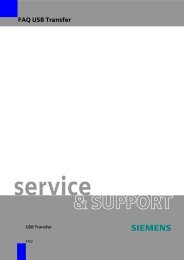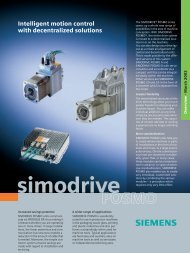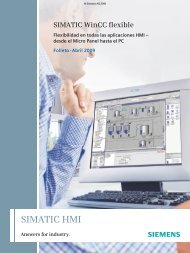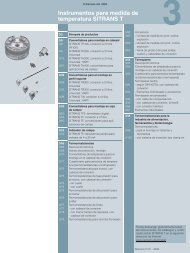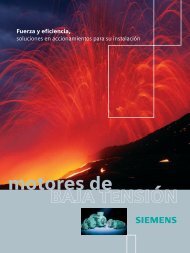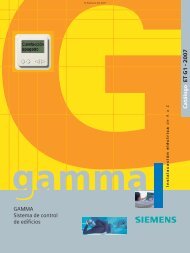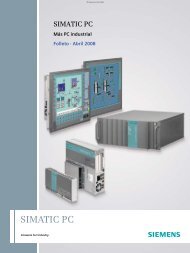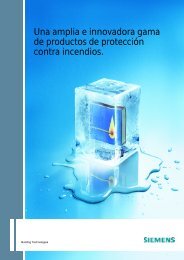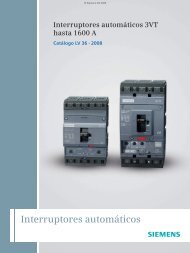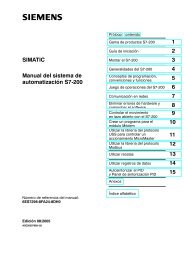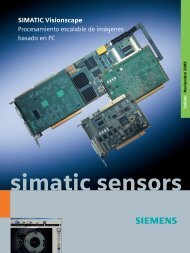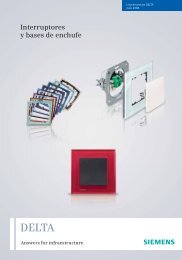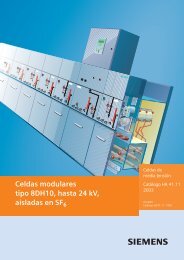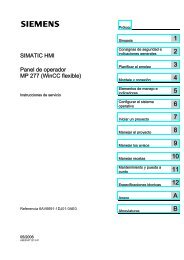Create successful ePaper yourself
Turn your PDF publications into a flip-book with our unique Google optimized e-Paper software.
Appendix<br />
© Siemens AG 2007<br />
Glossary<br />
■ Overview<br />
This glossary offers brief explanations of some of the terms used<br />
in this catalog. However it must not be regarded as a substitute<br />
for the actual text of the standard, especially where the new<br />
terms used in IEC/EN 60947 are concerned.<br />
(AC) Rating or rated power<br />
(see also IEC/EN 60947-1; 4.3.2.3)<br />
Altitude<br />
Ambient temperature, enclosed<br />
(see also IEV 441-11-13)<br />
Reference is made underneath each term to the relevant section<br />
in the standard, e.g. IEC/EN 60947-1. Additionally, IEV numbers,<br />
e.g. IEV 441-17-31, are stated in order to enable you to find foreign<br />
language equivalents in the International Electrotechnical<br />
Vocabulary (IEC 50).<br />
The operational power that an equipment is capable of switching at the<br />
associated rated operational voltage in accordance with the utilization<br />
category, e.g. contactor utilization category AC-3: 37 kW at <strong>40</strong>0 V.<br />
The density of air decreases with increasing altitude, and this reduces<br />
its insulating capacity as well as its heat transfer capability. The rated<br />
operational voltage and rated operational current of switching<br />
devices, conductors and motors as well as the tripping behavior of<br />
thermal overload relays are affected by this.<br />
Upon request, Siemens will supply information as to the suitability or<br />
otherwise of switchgear for operation at altitudes above the 2000 m<br />
limit specified by the standard.<br />
Please contact our local Siemens sales office or get in direct touch with<br />
Technical Assistance (see page 6/13).<br />
Temperature at which the switching device is capable of being operated<br />
within a closed enclosure. For this purpose, it must be taken into<br />
account that the heat losses of the device will add to the internal temperature<br />
rise within the enclosure.<br />
6<br />
Ambient temperature, open<br />
(see also IEV 441-11-13)<br />
Back-of-hand proof<br />
Clearance in air<br />
(see also IEC/EN 60947-1; 2.5.46/IEV 441-17-31)<br />
Closing delay<br />
Control circuit reliability<br />
Conventional free air thermal current I th<br />
(see also IEC/EN 60947-1; 4.3.2.1)<br />
Creepage path/distance<br />
(see also IEC/EN 60947-1; 2.5.51/IEV 151-03-37)<br />
Damp heat, constant<br />
Damp heat, cyclical<br />
Emergency-Stop switching device<br />
Finger-safe<br />
Room temperature (for example of the workshop or contact chamber)<br />
in which the switching device is located.<br />
An equipment whose live parts cannot be touched by a sphere of<br />
50 mm diameter is regarded as back-of-hand proof.<br />
The distance between two conductive parts along a string stretched<br />
the shortest way between these conductive parts. The clearance in air<br />
is determined by the rated impulse withstand voltage, overvoltage<br />
category and the pollution degree.<br />
The interval of time between the instant of command and the first make<br />
operation of the contacts of the first pole to close. The closing delay is<br />
made up of the response delay and the closing delay.<br />
Measures the probability of switching states arising during the endurance<br />
of a contact that would be interpreted as faults by downstream<br />
electronic controllers (PLCs). Control circuit reliability is expressed in<br />
values based on tests using standard limit values for signals according<br />
to IEC/EN 61131-2.<br />
The maximum value of current that an equipment is capable of carrying<br />
for a minimum of 8 hours without thermal overloading. As a rule, it<br />
corresponds to the maximum rated operational current.<br />
The shortest distance along the surface of the insulating material<br />
between two conductive parts. The creepage path/distance is determined<br />
by the rated insulation voltage, the pollution degree and the<br />
creepage current resistance of the material used.<br />
This test subjects the equipment to an ambient temperature of <strong>40</strong> °C at<br />
a constant humidity of 93%. At set intervals during the test, the electrical<br />
and mechanical function of the equipment are examined.<br />
This test subjects the equipment to cyclically changing climatic conditions.<br />
A cycle applies <strong>40</strong> °C ambient temperature at 93% relative<br />
humidity for 12 hours, followed by 12 hours of 25 °C at 95%. At set<br />
intervals during the test, the electrical and mechanical function of the<br />
equipment are examined.<br />
Switching device with an Emergency-Stop circuit that is intended to<br />
prevent danger to persons, damage to machinery or work materials.<br />
An equipment whose live parts cannot be touched by the operator during<br />
actuation is termed finger-safe. This also affects operator activity on<br />
neighboring switching devices. The finger-safe area of a push-actuated<br />
operating medium is a circular area of at least 30 mm radius around the<br />
actuating element, and vertical to the direction of actuation. Within this<br />
circular area, touch-critical parts must be located at not less than<br />
80 mm below the actuating level.<br />
6/2 Siemens LV 70 · 2006



